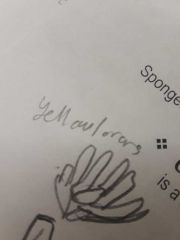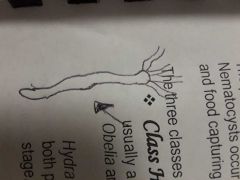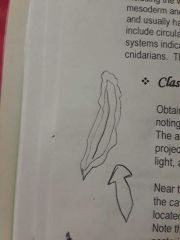![]()
![]()
![]()
Use LEFT and RIGHT arrow keys to navigate between flashcards;
Use UP and DOWN arrow keys to flip the card;
H to show hint;
A reads text to speech;
40 Cards in this Set
- Front
- Back
- 3rd side (hint)
|
Phylum Porifera |
Sponges , sessile(except when larvae) 3 cell layers Filter feeding Asymmetrical No tissue Spicule(skeleton subunit structure) |
Poress |
|
|
Animalia |
Multicellular External digestion No cell wall Sexual repro Tissue, not sponge Symmetry,not sponge |
|
|
|
Sponge - class Calcarea |

Skeletal spicules made of calcium carbonate |
|
|

Sponge - class hexatinellida |
Glass sponge, vase like form, solitary, deepwater Spicules, 6 point and siliceous |
|
|
|
Sponge- class demospongiae |
Largest class of sponges, include bath sponges, very bright, skeleton made of siliceous spicules,fibers |
|
|
|
Phylum Cnidaria |
Symmetrical Tissues 2 layers Nematocysts, stinging cells Radial symmetry |
|
|
|
Class Scyphozoa |
Phylum- cnidaria Jellyfish ,medusa |
|
|
|
Class anthozoa |
Phylum Cnidaria ONLYpolyp stage, complex body wall. Coral,sea anemones |
|
|
|
Class hydrozoa |

Polyp, |
|
|
|
Phylum Ctenophora |
Comb jellies, older than sponge Radial symmetry Biolumenescent cilia 2 layer |
|
|
|
Prostomates |
First opening mouth, blastophore becomes mouth |
|
|
|
Phylum platyhelminthes |
Flat worms, bilateral symmetry No respiratory, skeletal or circulatory system 3 cell layers, ectoderm, mesoderm, endoderm |
|
|
|
Class Turbellaria |

Free living flatworms ,planarians. Middle has cavities |
|
|
|
Class Trematoda |

Parasitic, flukes |
|
|
|
Class cercomeromorpha |
Phylum, platyhelminthes All parasitic, tape worms Proglottids, segmented eachhas reproductive system |
|
|
|
Phylum Rotifera |
Freshwater microorganisms, marine Corona,cilia around mouth Looks like wheel turning, |
|
|
|
Phylum Annelida |
Segmented worms, earth worms, Body cavity, controlled movement, |
|
|
|
Class Polychaeta |
Many hairs, largest annelids class, marine worms, well developed head, 2 eyes, 2 tentacles, second segemnt 4 pairs of lateral tentacles |
|
|
|
Class Clitellata |
Few hairs, earth worm,digestive,reproductive, circulatory,excretory system |
|
|
|
Class Clitellata |
Leeches, has blood anti coagulants that keep human blood flowing while sucks |
|
|
|
Phylum arthropoda |
Jointed appendages Chitin exoskeleton |
|
|
|
Subphylum Chelicerata |
Phylum Arthropoda Pincers , claws |
|
|
|
Class Merostomata |
Phylum Arthropoda Subphylum Chelicerata Horseshoe crab |
|
|
|
Class Arachnida |
Spider, scorpion, 2 body region Pair of chelicerae 4 pair legs |
|
|
|
Subphylum myriapoda |
Many Feet |
|
|
|
Class Chilopoda |
Phylum Arthropoda Subphylum Myriapoda, many feet CENTIPEDE |
|
|
|
Class Diplopoda |
Phylum Arthropoda Subphylum Myriapoda Millipedes |
|
|
|
Subphylum Mandibulata |
Phylum Arthropoda Mouth parts to get food |
|
|
|
Class crustacea |
Phylum Arthropoda Subphylum Mandibulata Crabs, lobsters, crayfish, pill bug, shrimp |
|
|
|
Class Insecta/Hexapoda |
Insects. ,most diverse group of organisms. More insect species than any phylum Body parts 3 Head Thorax Abdomen 2pair wings 3pair legs Pair antennae |
|
|
|
Deurostomates |
Spiky |
|
|
|
Phylum Echinodermata |
Radially Symmetrical Calcareous endoskeleton w spines All marine Only Echinoderms have water vascular system, motion,eat,breath |
|
|
|
Class Asteroidea |
Phylum Echinodermata All marine Radial symmetry STARFISH |
|
|
|
Class Echinoidea |
Phylum Echinodermata Skeletal plates fused solid, sea urchins, sand dollars |
|
|
|
Class Holothuroidea |
Phylum Echinodermata Sea cucumbers ,reduced skin look differ than others |
|
|
|
Class Ophiuroidea |
Phylum Echinodermata 5 arms Central disk Brittle stars Serpent star |
|
|
|
Class crinoidea |
Oldest echinoderms Sea lilies Feather stars |
|
|
|
Phylum Hemichordata |
Acorn worms have circulatory sys. Heart Gill like for breathing |
|
|
|
Phylum Chordota |
MOST HIGHLY DEVELOPED 1. Notochord, supports nerve chord become vertebrat3 in adults mostly 2.pharyngeal gill slits,suspension feeding divices in invertebrate . Gas exchange, jaw support, hear 3. Dorsal hollow nerve cord, become central nerv. Syst. Brain and spine 4. Post anal tail, in all embryos First two seen in all adults not human |
|
|
|
Subphyla vertebrate |
Phylum chordata Backbone Superclass- fish Superclass Tetrapoda- terrestrial Class Agnatha- jawless, eels,hagfish Class chondrichthyes- sharks,rays Class Osteichthyes- cod,tuna,bass,bony fish Superclass- land, 4 limbs Superclass- land, 4 limbs Superclass- land, 4 limbs |
|

